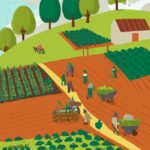Solutions to address food insecurity focus on various key areas. Firstly, investing in sustainable agriculture practices can enhance food production and decrease dependence on unpredictable weather conditions. This involves promoting crop diversification, improving irrigation systems, and supporting small-scale farmers. Additionally, implementing effective social protection programs such as cash transfers, school feeding initiatives, and food vouchers can provide crucial support to vulnerable communities. Enhancing access to credit and financial services for farmers can also stimulate their ability to invest in agricultural inputs and technologies. Lastly, fostering partnerships between governments, non-governmental organizations, and the private sector can facilitate coordinated efforts to combat food insecurity on a global scale.
One of the key solutions to address food insecurity is to promote agricultural development and productivity. This can be achieved by providing farmers with improved access to agricultural inputs, such as quality seeds, fertilizers, and modern farming technologies. Additionally, farmers can be trained on sustainable farming practices and techniques that can help them increase their crop yields and produce higher-quality food.
Another solution is to enhance food distribution systems, focusing on reducing post-harvest losses and improving infrastructure for the transportation and storage of food. Investments in cold storage facilities, transportation networks, and market infrastructure can help ensure that food reaches consumers without spoilage or wastage. Furthermore, the establishment of efficient and transparent market systems can help connect local food producers with consumers, improving their access to food and reducing food prices.
Promoting diversified and resilient food production systems is also crucial in addressing food insecurity. Encouraging the cultivation of a wide variety of crops, including traditional and indigenous crops, can enhance dietary diversity and contribute to more balanced nutrition. Moreover, supporting small-scale farming and agroforestry practices can help reduce vulnerability to climate change and increase the resilience of agricultural systems.
Addressing food insecurity requires tackling the underlying causes, such as poverty and inequality. This can be achieved by implementing social protection programs that provide vulnerable populations with access to affordable and nutritious food. These programs may include cash transfers, school feeding programs, and targeted nutrition interventions, ensuring that individuals have the means to secure their food needs.
Lastly, promoting sustainable intensification and climate-smart agriculture practices can help minimize the negative impacts of agriculture on the environment while increasing productivity. These approaches involve using resources efficiently, adopting climate-resilient farming techniques, and minimizing greenhouse gas emissions.
In conclusion, addressing food insecurity requires a multi-faceted approach that includes promoting agricultural development, enhancing food distribution systems, supporting diversified food production, addressing poverty and inequality, and adopting sustainable agricultural practices.
Causes of food insecurity
Food insecurity is a complex issue that affects millions of people worldwide. Understanding the causes of food insecurity is crucial in order to develop effective solutions. There are multiple factors that contribute to food insecurity, including:
1. Poverty: Poverty is often considered the main cause of food insecurity. Inadequate income and lack of resources prevent people from accessing nutritious food on a regular basis. Poverty can result from various factors such as unemployment, low wages, lack of education, and unequal distribution of resources.
2. Climate change and environmental degradation: Climate change and environmental degradation significantly impact food security. Rising temperatures, extreme weather events, droughts, and floods can lead to crop failure, reduced agricultural productivity, and loss of livestock. These factors directly affect the availability and affordability of food, particularly for communities dependent on agriculture.
3. Conflict and political instability: Food insecurity is frequently associated with regions experiencing armed conflicts, civil unrest, or political instability. These circumstances not only disrupt agricultural activities but also displace communities, hinder trade and transportation, and limit access to food sources. Conflict and insecurity also hinder the implementation of long-term solutions to address food insecurity.
4. Lack of access to land and resources: Limited access to land, water, and other resources necessary for agriculture can contribute to food insecurity. This is particularly relevant in rural areas where small-scale farmers may face challenges in accessing suitable land, secure tenure, and adequate irrigation facilities. Land grabbing, unequal land distribution, and lack of property rights exacerbate the problem.
5. Unstable global food markets: Fluctuations in global food prices can heavily impact food security, particularly in countries that heavily rely on food imports. Changes in commodity prices, trade policies, and market speculation can make food less affordable and less accessible for vulnerable populations.
6. Unequal distribution of resources: Unequal distribution of resources, such as income, land, and power, contributes significantly to food insecurity. When power and wealth are concentrated in a few hands, marginalized groups such as women, children, and ethnic minorities bear the brunt of food insecurity.
7. Lack of agricultural infrastructure and technology: Insufficient investment in agriculture and inadequate infrastructure, such as irrigation systems, storage facilities, and transportation networks, can hinder agricultural productivity and prevent farmers from utilizing their full potential. The lack of access to modern technologies and agricultural inputs further exacerbates food insecurity.
8. Gender inequality: Gender inequalities contribute to food insecurity, often leaving women and girls disproportionately affected. Discrimination, limited access to resources, and unequal participation in decision-making processes restrict their ability to produce and access food.
By examining these causes, policymakers, governments, and organizations can develop comprehensive strategies and interventions to address the underlying factors contributing to food insecurity. Only by understanding and targeting these root causes can we strive towards a world where everyone has access to sufficient, nutritious, and sustainable food.
Government policies and initiatives
Government policies and initiatives play a crucial role in addressing food insecurity within a country. These policies and initiatives are specifically designed to ensure that individuals have access to safe, nutritious, and affordable food. In this article, we will explore some of the key government policies and initiatives that can help combat food insecurity.
One of the most fundamental government policies is the formulation of food security strategies and plans. These plans outline the government’s objectives, targets, and actions to improve food availability, accessibility, and utilization. They often involve partnerships between various stakeholders, such as farmers, NGOs, and international organizations, to enhance agricultural productivity, promote sustainable farming practices, and strengthen supply chains.
Another important initiative is the development of social safety net programs. These programs aim to provide support to vulnerable populations and ensure their access to food. This can include cash transfers, food vouchers, or direct provision of essential food items. Governments often prioritize these safety nets for low-income households, pregnant women, children, the elderly, and individuals with disabilities.
Additionally, governments can implement agricultural subsidies and incentives to encourage farmers to increase productivity and improve food availability. These subsidies can take various forms, such as access to credit, fertilizer subsidies, or technical assistance. By making these resources more readily available, governments can incentivize farmers to invest in their land, adopt modern farming techniques, and achieve higher yields.
Furthermore, many governments establish national nutrition policies and programs to address food insecurity. These initiatives aim to improve the nutritional status of individuals, particularly children and pregnant women, by promoting healthy eating habits and providing access to essential nutrients. They may include school feeding programs, nutrition education campaigns, and the fortification of staple foods with key micronutrients.
In some cases, governments may also regulate food markets to ensure fair prices, prevent hoarding, and combat food wastage. These regulations can include price controls, quality standards, or the establishment of strategic food reserves. By maintaining stability and transparency in the food market, governments can help stabilize prices and ensure adequate food supply.
Government policies and initiatives can also focus on agricultural research and development. By investing in scientific advancements, governments can improve crop varieties, develop drought-resistant crops, and enhance agricultural technologies. These innovations can lead to increased productivity, reduced post-harvest losses, and more efficient use of resources, ultimately contributing to improved food security.
In conclusion, government policies and initiatives are essential in addressing food insecurity. Through the formulation of strategies, social safety net programs, agricultural subsidies, nutrition policies, market regulations, and investments in research and development, governments can effectively tackle the root causes of food insecurity and ensure that all individuals have access to sufficient and nutritious food.
Sustainable agriculture practices
Sustainable agriculture practices are methods and techniques used in farming that prioritize long-term environmental stewardship, economic viability, and social equity. These practices aim to ensure food production and farming systems that are environmentally friendly, economically profitable, and socially responsible. Here are some key aspects of sustainable agriculture:
1. Crop rotation: Crop rotation involves growing different crops in a particular field over a sequence of years. It helps to prevent the buildup of pests and diseases, maintain soil fertility, and reduce the need for chemical fertilizers and pesticides.
2. Agroforestry: Agroforestry is the integration of trees and shrubs into agricultural systems. This practice enhances biodiversity, improves soil quality, conserves water, and provides additional income opportunities for farmers through the sale of timber, fruit, or nuts.
3. Precision agriculture: Precision agriculture uses technology, such as GPS and remote sensing, to optimize resource use and reduce waste. By employing site-specific management techniques, farmers can apply fertilizers, water, and other inputs in the right amount, at the right time, and in the right place.
4. Conservation tillage: Conservation tillage aims to reduce soil erosion, preserve moisture, and enhance soil health by minimizing the disturbance of soil through methods like no-till or reduced tillage. These practices help to maintain soil structure, increase organic matter content, and sequester carbon.
5. Integrated pest management (IPM): IPM is a holistic approach to pest control that combines several strategies to minimize the use of synthetic pesticides. It involves monitoring pests, using natural predators and beneficial insects, practicing crop rotation, employing resistant crop varieties, and utilizing cultural practices to reduce pest populations.
6. Water management: Sustainable agriculture promotes efficient water use through practices such as drip irrigation, rainwater harvesting, and the use of drought-tolerant crop varieties. Proper water management helps to conserve this vital resource, reduce water pollution, and support the resilience of agricultural systems in the face of climate change.
7. Organic farming: Organic farming avoids the use of synthetic fertilizers, pesticides, genetically modified organisms (GMOs), and antibiotics. Instead, it relies on organic inputs, crop rotation, and biological pest control to maintain soil fertility, protect pollinators, and minimize environmental impact.
8. Livestock management: Sustainable livestock management involves responsible animal husbandry practices that prioritize animal welfare, reduce environmental pollution, and optimize resource efficiency. Examples include rotational grazing, use of feed additives to reduce methane emissions, and responsible manure management.
9. Community engagement: Sustainability in agriculture also encompasses social and economic factors. Encouraging local food production, supporting small-scale farmers, strengthening agricultural cooperatives, and promoting fair trade practices all contribute to long-term agricultural sustainability.
Overall, sustainable agriculture practices are crucial for ensuring the availability and accessibility of nutritious food while protecting natural resources, supporting rural livelihoods, and mitigating the impacts of climate change. By incorporating these practices, we can create a more sustainable and resilient food system for future generations.
Community-based solutions
Community-based solutions are promising approaches to address food insecurity. These solutions involve local communities working together to tackle the issue at a grassroots level. By empowering and engaging community members, these initiatives aim to create sustainable and long-term solutions. Here are some key aspects of community-based solutions to address food insecurity:
1. Community Gardens: Creating community gardens is an effective way to provide access to fresh, nutritious food. These gardens can be established in urban areas or even in rural communities, allowing residents to grow their own produce. Community gardens not only provide a source of healthy food but also promote social interaction, skill-building, and a sense of ownership.
2. Farmers Markets: Supporting local farmers markets is another community-based solution. These markets provide a platform for local farmers and small-scale food producers to sell their products directly to consumers. By promoting local agriculture, these markets help stimulate the local economy while offering fresh, affordable food options to community members.
3. Food Co-ops: Community-owned food cooperatives are another effective approach to addressing food insecurity. These cooperatives operate on a shared ownership model, where community members come together to collectively purchase and manage a grocery store or food distribution center. By pooling resources and buying directly from farmers and producers, food co-ops can provide affordable and high-quality food options to their members.
4. Community Meal Programs: Organizing community meal programs can help ensure that everyone has access to regular, nutritious meals. These programs can take the form of soup kitchens, community dinners, or food sharing initiatives. They not only help alleviate immediate hunger but also foster a sense of belonging and social connection within the community.
5. Food Education and Skill-Building: Community-based solutions often focus on education and skill-building to empower individuals to make healthier food choices and become more self-sufficient. Programs that offer cooking classes, nutrition workshops, and gardening workshops can equip community members with the knowledge and skills necessary to grow and prepare nutritious meals.
6. Food Recovery Programs: Community-based food recovery programs aim to reduce food waste and redirect surplus food to those in need. These programs involve partnerships with local businesses, farms, and restaurants to collect and distribute excess food to community organizations or directly to individuals facing food insecurity.
7. Policy Advocacy: Community-based solutions also involve advocating for policies that address the root causes of food insecurity. By working with local government officials and policymakers, communities can push for initiatives such as increasing funding for nutrition assistance programs, supporting sustainable agriculture practices, and creating zoning regulations that encourage the establishment of community gardens and farmers markets.
In summary, community-based solutions are vital in addressing food insecurity as they engage and empower local communities to take action. By implementing initiatives such as community gardens, farmers markets, food co-ops, and educational programs, communities can create sustainable solutions that promote food security, social connectivity, and economic development.
International collaborations.
International collaborations play a crucial role in addressing the issue of food insecurity around the world. By bringing together governments, organizations, and individuals from different nations, international collaborations can pool resources, knowledge, and experiences to develop effective solutions to ensure food security for all.
One key aspect of international collaborations in addressing food insecurity is sharing best practices and successful strategies. Different countries have faced various challenges and have implemented innovative solutions to overcome them. By sharing these successes, nations can learn from one another and adapt strategies to fit their own context. This exchange of knowledge helps to enhance the overall capacity for tackling food insecurity globally.
Furthermore, international collaborations allow countries to coordinate efforts and establish partnerships to address common issues related to food security. This can involve initiatives such as research collaborations, joint projects, and development of policy frameworks. For example, countries can work together to improve agricultural practices, enhance food production and storage systems, and establish safety nets to protect vulnerable populations from food crises. These collaborative efforts help to foster a collective approach to food security, promoting information-sharing, and resource allocation.
International collaborations also provide opportunities for financial and technical assistance. Developing countries often face significant challenges in addressing food insecurity due to limited resources and infrastructure. Through collaborations with wealthier nations or international organizations, support can be provided in terms of financial aid, technology transfer, and capacity-building initiatives. This assistance can help developing nations to improve their agricultural practices, implement sustainable food production methods, and strengthen their resilience to climate change and other external impacts.
Another critical aspect of international collaborations is the establishment of global frameworks and agreements to address food insecurity. International organizations, such as the United Nations’ Food and Agriculture Organization (FAO), facilitate discussions and negotiations between countries to develop policies and guidelines that promote food security at a global level. These frameworks provide a platform for countries to commit to specific targets, share responsibilities, and collectively work towards achieving sustainable food systems.
In summary, international collaborations are essential in addressing food insecurity because they promote knowledge-sharing, coordinate efforts, provide financial and technical assistance, and establish global frameworks. By working together, nations can develop and implement effective solutions to ensure food security for all. It is through these collaborative endeavors that we can strive to eliminate hunger and achieve sustainable development across the globe.
External Links
- What Causes Food Insecurity and What are Solutions to It?
- The United States Can End Hunger and Food Insecurity for Millions …
- Reduce household food insecurity and hunger — NWS‑01 – Healthy …
- Causes, Effects and Solutions to Food Insecurity (Lack of Access to …
- 8 Best Ways to Combat Food Insecurity in Your Community













